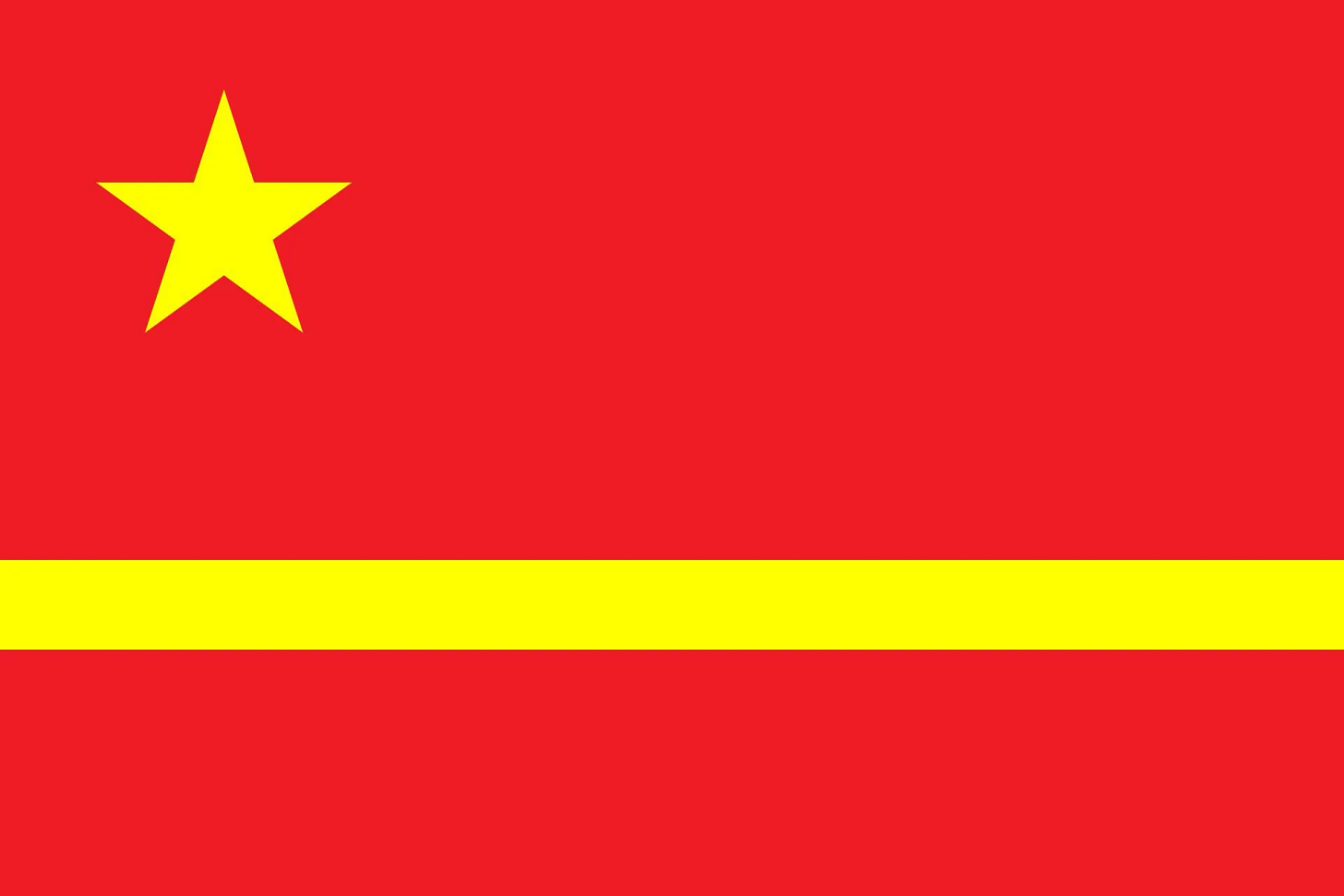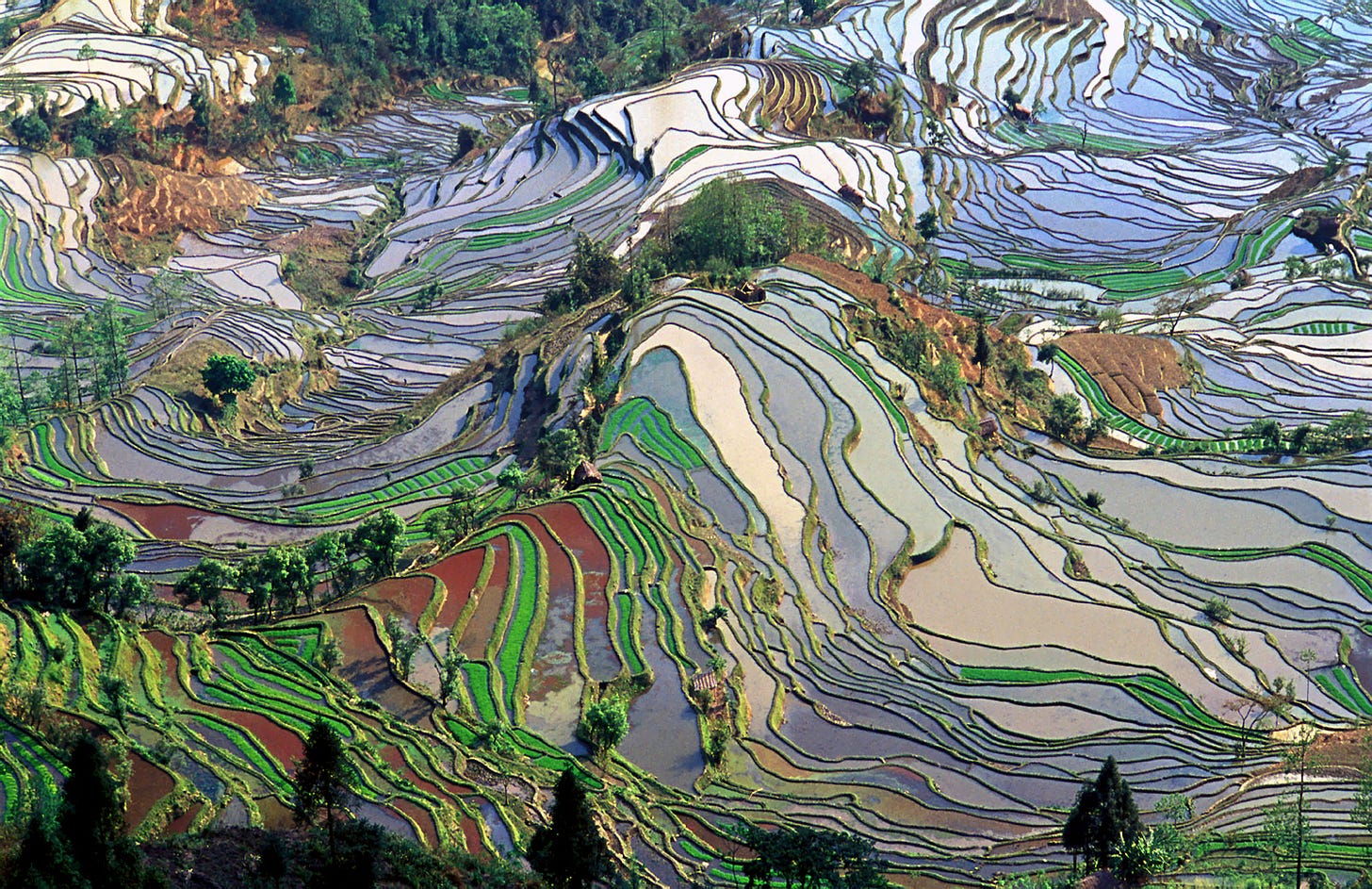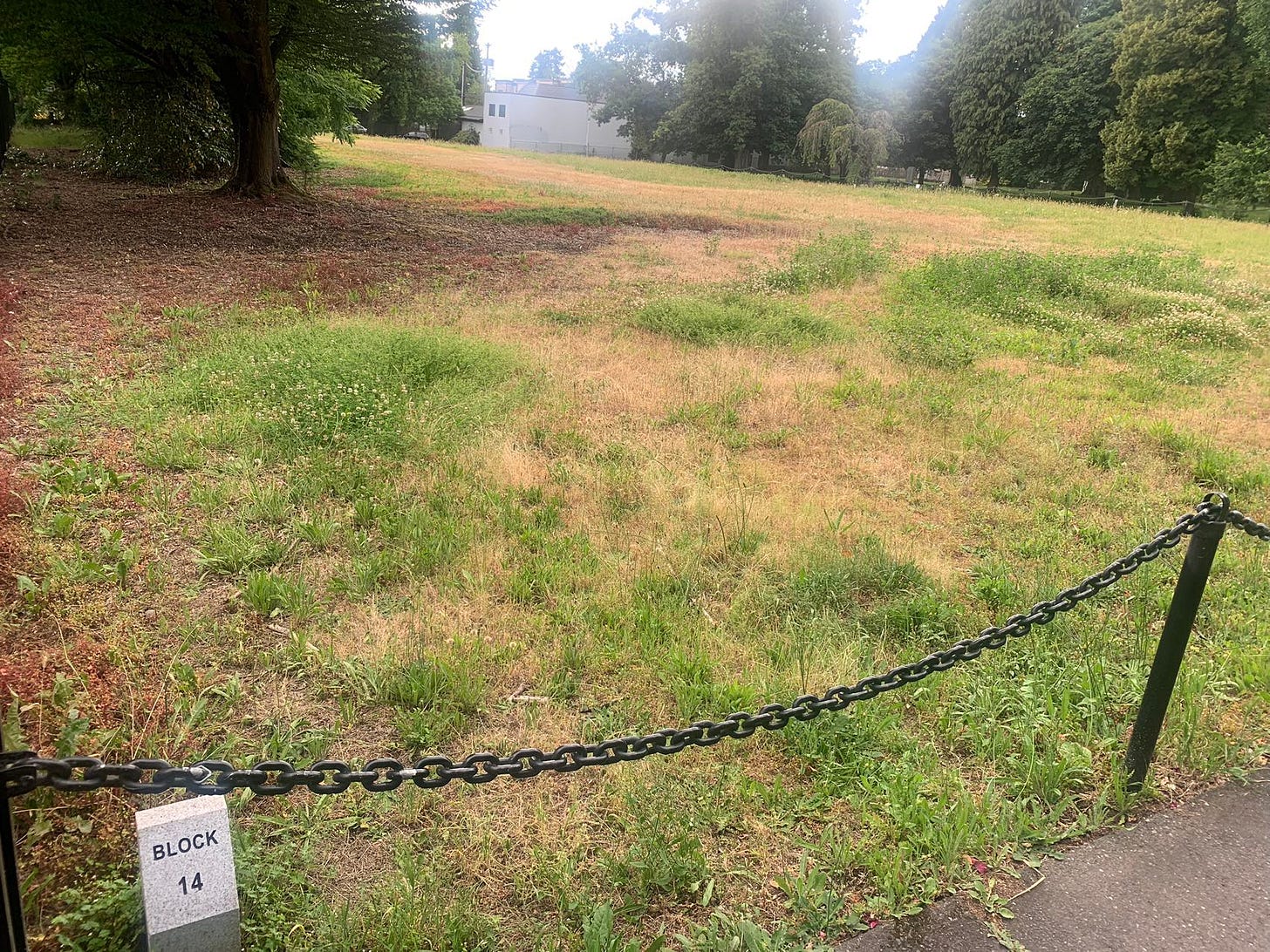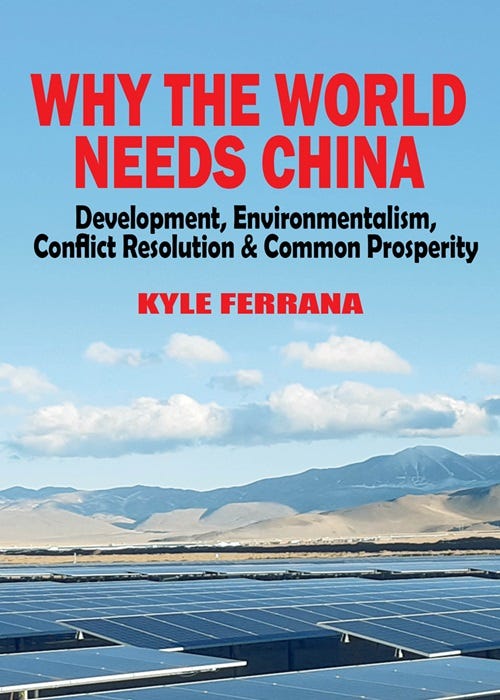Ocean Elegy
Why the future is Chinese, and the past is American.
This essay was originally intended as a concluding chapter to Why the World Needs China, but I found the scope kept expanding as I wrote, so I decided to publish it separately as a companion piece. It can be read before or after the book.
In the summer of 1949, the Chinese Civil War was all but won. The People’s Liberation Army had crossed the Yangtze River, seized Shanghai and the Nationalists’ capital city Nanjing, and driven the Nationalist forces into a retreat that would eventually result in their long exile in Taiwan. After two entire decades of war, the Communist Party finally had to prepare not just to liberate their country but to rule it, and among the many administrative decisions that needed to be made, there was the question of the new national flag.
A notice was posted in the People’s Daily and other newspapers soliciting designs. Over three thousand submissions were received, and a special committee carefully selected the best candidates for deliberation at the upcoming session of the Chinese People's Political Consultative Conference. The iconic five-star banner that today symbolizes the People’s Republic was not among them. Instead, one of the most popular finalists, and the one initially preferred by Mao Zedong, was a relatively simpler pattern of only a single star, representing the Party, above a horizontal yellow stripe, which represented the Yellow River.1 Some other contenders were variants of this design, adding an additional stripe representing the Yangtze or a third for the Pearl River. It would be difficult to name a better symbol for the complex legacy of the Yellow River, and more generally the importance of water to the development of Chinese civilization, than this selection process—particularly because none of these designs were ultimately adopted.
“Do you know how many bends there are in the Yellow River?” asks a famous folk song from Shaanxi Province. Using a straight, horizontal line to represent such a tortuous artery of the lifeblood of China’s agriculture would be unscientific, a prestigious general who had recently defected from the Nationalists is said to have reminded Mao. But more importantly, a stripe in the flag’s design would have suggested a divided country at a time when unity was badly needed.
This was not the first time that China’s second-longest river was looked upon as a symbolic obstacle to social progress, nor would it be the last. Nearly four decades later, an infamous Chinese documentary series broadcast on state-run television would condemn the Yellow River as the origin of a backward and stagnant culture that had stubbornly persisted until the modern day. The series was titled Héshāng (河殇); hé (河) meaning river and shāng (殇) meaning “to die prematurely,” thus the English title was literally The River Dies Young—or, as it is more commonly translated, River Elegy.
The “Hydraulic Society”
The River Elegy series caused great disruption, debate, and controversy not only among the Chinese public but at the highest levels of the Communist Party. It was considered a fierce repudiation of Chinese culture and tradition, criticizing virtually everything from the Great Wall to national sports teams. All such problems, it suggested, were rooted deep in history. The fertile Yellow River basin, the cradle of Chinese civilization, had sustained it for millennia—but in a feudal eternity, tragic and rigid, insular and changeless.
“Perhaps you will be puzzled if someone tells you that oriental despotism was related to water,” said River Elegy, but “[i]n fact, this was Marx’s and Engels’ view.”2 The vagueness, inconsistency, and incompleteness of Marx’s writings on colonial India have indeed spawned well over a century of bitter arguments that continue to this day, not only on the question of to what degree Marxism was applicable outside of the context of European class oppression under which he lived, but also to what degree he believed that a distinct “Asian” mode of production existed. The simplicity and the traditional division of labor within the ancient Indian communal village, Marx wrote in Capital, was the secret of their unchangeableness; despite the never-ceasing changes of dynastic masters, “[t]he structure of the economic elements of society remains untouched by the storm-clouds of the political sky.”3 According to historian and prominent Marxist Dr. Walter Rodney, “[Chinese] landowners had greater powers as bureaucrats than as men of property,” and therefore, for thousands of years, “they used that to keep social relations in the same mould.”4 (Such a bureaucracy was meritocratic, rather than based on inheritance, though of course those who were already wealthy had the greatest advantages in gaining access to it.) A deceptively simple and intuitive material reason for why this “feudalism” was technically distinct from Europe’s has historically been suggested: in rainy, temperate pre-capitalist Europe, the peasant and his family could survive independently, through the subsistence farming of grain upon a modest plot of land—while in southern and eastern Asia, it was a fact of life that no man could grow rice on his own. The rice plant traditionally thrives when submerged in water to a consistent level; the “oriental climate,” according to the documentary, “made large-scale man-made irrigation the first prerequisite for agriculture.”5
Idyllic photographs of the vast arrays of terraced rice paddies in China or its neighbors can sometimes evoke awe in a Western audience. Yet it was not Marx but German historian Karl Wittfogel who, nearly a century after the publication of Capital but less than a decade after the creation of the PRC, codified in the Western discourse a more sinister and essentialist reaction with his concept of the “totalitarian” “hydraulic society.” As River Elegy described it:
…[S]uch work could only be done by mobilizing the masses under a centralized despotism regime. This was the well-known “Asiatic production mode.” Myriad insignificant individuals organized to support the supreme being on top... Thus, democracy, freedom, and equality had little chance of becoming ‘Asiatic.’6
These were the origins of the Western orientalist myth that Asian states remain somehow exceptionally “authoritarian” and constantly in need of more Western “democracy.” Having assigned “despotism” its ancient material origin, Wittfogel and other pro-Western analysts could then pretend that it was an indelible mark of Chinese culture—and that any modern expression of collectivism in China was therefore equivalent to despotism.
The makers of River Elegy relentlessly perpetuated this myth in not-so-subtle terms. There was an old saying, they reminded the country, that a dipperful of the Yellow River would be 70% loess.7 “Where are the roots of the Chinese nation?” they asked. “Perhaps every yellow-skinned Chinese knows this: the Yellow River.”8 This defect, they asserted, could be surmounted in only one way.
Oh, descendants of the dragon, the Yellow River has given us all it could to our ancestors. It cannot give birth again to the civilization created by our ancestors. We must create a brand-new civilization, one which cannot flow from the Yellow River. The dregs of the old civilization, like the silt in the Yellow River, have built up in our nation’s blood vessels. It needs a good scrubbing by a great flood. The flood has come. It is industrial civilization. It is calling us.9
The Chinese people, the documentary said, had a “mental block”;10 to remove the metaphorical mud from the veins of the river civilization, it urged an even greater shift—encompassing not just the cautious and controlled economic liberalization of the Reform and Opening Up policy, but a total cultural reset and an uncritical ideological embrace of the individualist (and therefore somehow non-“despotic”) West:
To save the nation from extinction, we had to keep the invaders out. But to save a declining culture, we must open the nation’s doors, to embrace the new dawn of science and democracy…11
We have seen the Yellow River flows for 10,000 li to end up in the sea. We must never again turn down the invitation by the sea.12
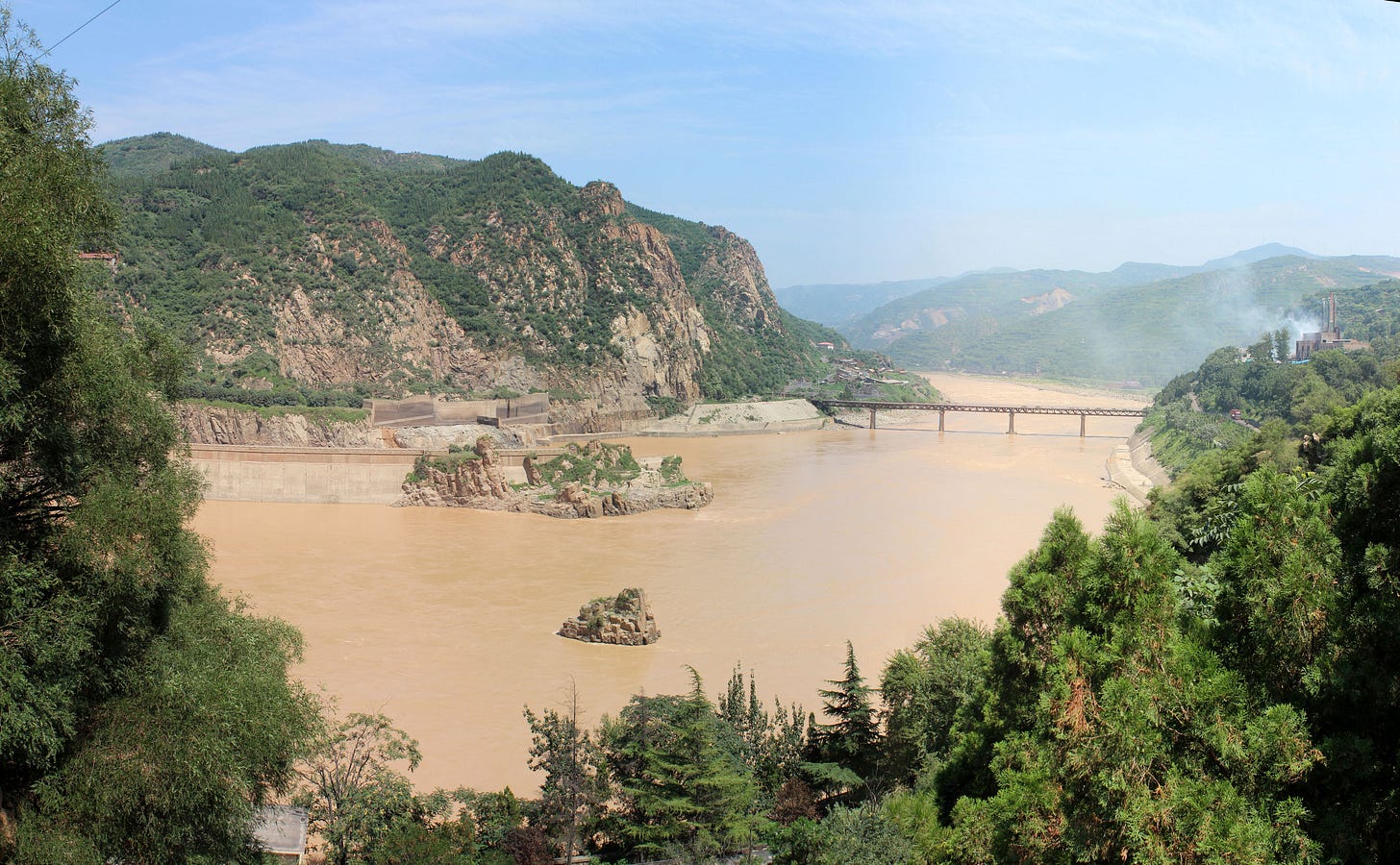
River Elegy considered the wide blue ocean to be the answer to the backward yellow soil. “The eternally restless blue waves of the Pacific Ocean have always beckoned the Chinese people,”13 it concluded. To the documentary’s makers, the Pacific symbolized Western civilization and the United States in particular. During the late 1980s, the “ocean” of global capitalism seemed not only the sole alternative to China’s supposed eternal stagnation, but the most vital force in the world. It represented a release from agricultural tyranny; it promised the freedom, the innovation, and the adventuresome, democratic spirit of the “beautiful country.”14 In the West, we know what a crock all of that is.
“What Are You Gonna Do About It?”
For all of human history before the twenty-first century, and for tens of millions of years before even the first hominid drew upon the wall of a cave, there were seven continents on the Earth. Today, there are eight. The newcomer lies near the center of the world’s vastest ocean, equidistant, more or less, from China and the United States. In a 2018 Scientific Reports article, researchers estimated its size at over 1.6 million square kilometers,15 though its total land area was zero—for it is composed not of land, but of plastic trash, overwhelmingly produced by Western countries and multinational corporations.16 Such is the legacy of an ocean civilization.
The crossing of the world’s oceans was indispensable to the development of capitalism. Only through the navigation and mastery of the Atlantic were the old European empires capable of enforcing a global division of labor, and only through this world-historical shift could the European capitalists ascend to become the world’s rulers. During the fifteenth century, the greatest power in the world by far was not any European kingdom, but China’s Ming Dynasty; according to Rodney’s historical analyses, the development of European civilizations, in fact, was until that time still comparable to West and East African civilizations in most respects.17 Even the ascendant Ottoman Empire, whose control of eastern trade routes provided an impetus for European exploration, was strong enough to challenge nearly all of Europe combined. Despite the Europeans’ inauspicious position, however, their edge in naval technology and resulting monopoly on maritime commerce was so significant that it provided the mechanism for European countries to subjugate Africa, the Americas, and eventually Asia. There is little wonder, therefore, that Chinese perspectives on the West’s rise might also focus on its relationship with water and describe global capitalism as the product of an “ocean” or “maritime” civilization.
“The maritime world view,” writes Professor Wang Yiwei, former diplomat and director of the Center for European Studies at Renmin University of China, “acknowledges no place as being inaccessible.”18 Microscopic particles of plastic have been discovered everywhere in the world, in every ocean, at the summit of Mount Qomolangma,19 and even within our own bodies. Another study conducted in the Netherlands and published in Environment International detected a quantifiable concentration of microplastics within the blood of 77% of volunteers from the general public in 202220—making both real and measurable the quality that the makers of River Elegy had lamented only in metaphor thirty-five years earlier.
Environmental destruction is certainly not the ocean civilization’s only deficiency, however. Though the United States trails China in every category when it comes to fighting climate change, it is by far the world leader in mass shootings, especially of schoolchildren. Its infrastructure, once the envy of the world, is decaying and collapsing before our eyes. The world’s largest rail network is now a warped, rickety, obsolete behemoth, each rattling freight train a potential environmental catastrophe on the level of the toxic chemical spill in East Palestine, Ohio in February 2023. Its population has been mostly urbanized and proletarianized—but then proletarianized again, and again, as the most precarious workers must take on additional “gig economy” jobs to pay their ever-increasing rent. An overly militarized police force, notorious worldwide for its racial prejudice, brutally enforces great disparities in wealth in all major U.S. cities. Homelessness in the U.S. is now at the highest level ever recorded.21 The internet, one of the greatest inventions of the West and the best tool of knowledge and learning of the modern era, has been hollowed out by a profusion of scams, hoaxes, time-wasting apps, corporate advertisements, AI-generated noise, and impotent partisan rage. If a reader who has lived in a U.S. city cannot add a dozen more grievances from personal experience, then their experience has been far from typical; and the worst problem on the list, of course, is that unlike in China, it seems that nothing whatsoever can be done about any of them.

Among the American people, and particularly the youngest generations, there is a radicalism and a hunger for change that has forever been denied even a single meal. Wall Street is once again occupied only by bankers. The construction of the Dakota Access Pipeline was not prevented. Bernie Sanders did not win; he did not win, again; we know now that he will never win. Social democracy was once considered a safe alternative to revolution; in the West today, not even social democracy can be won without a revolution.
Its harshest critics judge Western social democracy to have been a “bribe” to buy the common Westerner’s support for imperialism, but if true, that bribe is grower ever more meager. In the latter twentieth century, according to Ghanaian president and political theorist Dr. Kwame Nkrumah, Western capitalism had “avoid[ed] sacrificing the all-important principle of ever-increasing profits for the owning minority” by increasing imperialist exploitation of the periphery through neocolonialism;22 yet as so many have seen, this exploitation had already been maximized under the neoliberal phase of imperialism. The twentieth century peak of wealth redistribution in Western capitalist countries is long past and shows no sign of returning. Brutal class struggle, not compromise, is on the domestic horizon. Now that using the carrot would risk the perpetual increase in their profits that they have thus far sustained throughout history, Western capitalists will eventually come to rely solely upon the stick. They sneer, in the manner of a school bully, “What are you gonna do about it?”
As of this writing, the new generation’s frustration found its greatest expression in the summer of 2020. The Black Lives Matter movement had already existed for seven years before the murder of George Floyd in Minneapolis, yet the demand for justice in his name spread much further, and the country-wide uprising that followed was much larger than had been reached on the behalf of earlier victims. The people of the United States felt a collective power that was their own and sought a change far beyond the incarceration of just one murderer with a badge. “Defund the police!” was the most common demand, though some gave voice to a desire to see them abolished entirely.
A few months later, the police were not abolished. Nor were they particularly defunded. That September, Bloomberg reported that of the 34 major U.S. cities that had already finalized their 2021 budgets, more than half increased or had no change in their police departments’ share. Across all such cities measured, police funding had dropped by less than one percent overall,23 but even this would not last long. In 2022, ABC reported that out of 109 major cities and counties measured, 91 (or 83%) had in fact increased their police budgets compared with 2019—most of them by more than 10%.24 Municipal governments that had promised dramatic cuts, such as San Francisco25 and Seattle,26 quietly walked them back; incumbent Democratic Party legislators who in 2020 had parasitically associated themselves with the protests frantically disavowed their actions before the midterm elections of 2022, shamelessly professing in debates and televised campaign ads their love for the increasingly militarized police and their intention to even further increase bloated police budgets. In the following year, more people were killed by U.S. law enforcement than in any year in the past decade.27 Compared with the intensity of the mass uprising, which had left a Minneapolis police headquarters a charred ruin, the protests that had ended Zero-Covid in China appeared particularly tame—yet the contrast between each governments’ responses was just as stark.
From the Zero-Covid protests to mortgage strikes, Chinese protestors engaged in collective resistance in recent years have received what they demanded conspicuously often. In 2021, in a manner typical of the Western media’s orientalist legacy, CNN called the clear blue skies of Beijing—which only seven years before had been shrouded in smog—a “rare victory for public dissent,” citing the public outrage and numerous protests that had driven the government to declare a national “war against pollution” in 2014.28 By the end of the decade, such a reduction in pollution had been made that it increased the average life expectancy in China by two years. It is strange that the people of China should be enjoying quite so many “rare” victories—if only public dissent could win equally as rarely on the opposite shore of the Pacific! The United States’ average life expectancy, stagnant for nearly a decade before 2019, fell by about three years by 2021, while China’s surpassed it and continued a steady increase.29 It is not the river but the ocean that dies young.

The fact that River Elegy had been broadcast by state-run CCTV seems evidence of just how terrible a risk the Party had taken by pursuing Reform and Opening Up. The fragility of the Party’s long-term strategy for development and indeed its own commitment to socialism were not imaginary; the entire world outside China has been living through a profoundly counterrevolutionary era ever since. During a desperate siege, the Politburo itself had carelessly almost left the gate wide open. The capitalist-controlled governments of the West and their neoliberal policies, however, do not appear to be under threat today—not from the PRC, and least of all from their own citizens.
Class Rule and the Sweetness of Liberty
The idea that a government can be so oppressive and powerful that it can only be overthrown by an external force is not uncommon in the West and has been a favorite of modern orientalists. Wittfogel makes clear his own belief in it with his best-known work Oriental Despotism: A Comparative Study of Total Power, which contains his hydraulic hypothesis in its canonical form. His anti-communism, however, contorts in an almost comical fashion any semblance of the materialist analysis of agriculture and irrigation that he purports to make. “Despotic” societies were somehow found across an entire continent’s range of climates, while Japan, with a staple crop and climate virtually identical to China’s, was an exception—one that apparently by sheer coincidence conformed exactly to the geographical limit of U.S. military influence after the Chinese Civil War. Moreover, the outcome of the Civil War, and the destruction of the landowning class that had historically maintained and benefited from China’s interminable “Asian mode of the production” for millennia, were apparently of no real significance. “Communist totalitarianism,” said Wittfogel, was only the latest and the “much more despotic” variant of the hydraulic society30—and one that its subjects were helpless to end by themselves. In his conclusion, he relates this anecdote from ancient Greece:
On their way to Suza, the Spartan envoys were met by Hydarnes, a high Persian official, who offered to make them mighty in their homeland, if only they would attach themselves to the Great King, his despotic master. To the benefit of Greece—and to the benefit of all free men—Herodotus has preserved their answer. “Hydarnes,” they said, “thou are a one-sided counselor. Thou hast experience of half the matter; but the other half is beyond thy knowledge. A slave’s life thou understandest; but, having never tasted liberty, thou canst not tell whether it be sweet or no. [emphasis added] Ah! hadst thou known what freedom is, thou wouldst have bidden us fight for it, not with the spear only, but with the battle-axe.”31
As long as U.S. hegemony and the neoliberal phase of global capitalism still last, the question that must be asked instead is whether Western—and particularly the United States’—governments are actually so powerful that their oppression can only be overthrown by an outside force. Internal resistance, as described above, is having almost no effect. The endless defeats suffered by the Western left have all but destroyed all the ideological consistency, the effectiveness, and certainly the vision that it ever possessed; hopelessness and “doomerism” predominate, finding their greatest expression in spontaneous vandalism or vehement internecine strife. But is there any wonder? What the people of the West—and the world—desperately need, before any invasion or force of arms, is an example—not just one of a better future, but of how to get there.
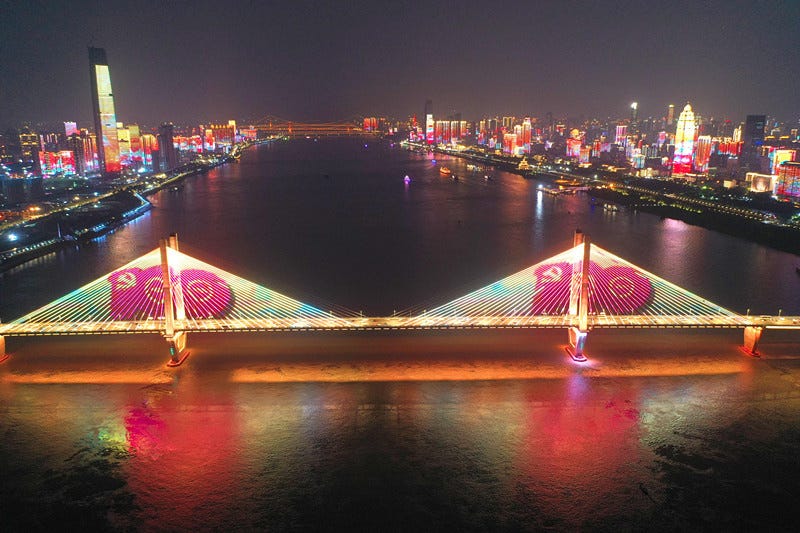
The community of those who would defend China’s socialist construction in the English-speaking arena is not large nor does it consist mostly of Chinese communists,32 sympathetic Western Marxists, or of other Marxists around the world. Instead, the state-run English-language Chinese press—in the same awkward and reactive manner in which it stumbles its way through American cultural issues that it seems ill-equipped to touch—has chosen to employ or grant the largest platforms to Western émigrés, businessmen, and apolitical tourists. Most of these advocates, though earnest in describing their observations of the Communist Party’s success, either do not understand, do not care, or are discouraged from explaining why it has succeeded. The tools of comparative analysis can readily prove how. While we can observe that China endured while the Soviet Union expired, that China is soaring while India is struggling, that China is building while the U.S. is bombing, and that China advanced by decades while Japan lost them, for such analyses to ultimately prove useful, the most fundamental reason behind these differences must also be exposed. River Elegy itself was eventually denounced by the Party and CCTV later broadcast a self-criticism;33 but unfortunately, the concepts of the class struggle and the class character of the state still seem as foreign to the PRC’s foreign-language press as was the sea to the frog in the well.34
For clearly, a disregard for class is likewise where the fault with the hydraulic hypothesis lies. It is human cooperation and organization, rather than despotism, that builds any and all great agricultural works, builds modern cities and infrastructure, cures diseases, spreads literacy, and discovers new sciences. It is these forces that propel history forward and none other. It is true that such things are constructed under the direction of bureaucracies, but what in history has not been? A bureaucracy of and for the class that performs such labor can do the same, and better, faster, and far more democratically than one based on exploitation. In Portland, Oregon, less than one mile from where these words were written, lies a mass grave of Chinese workers—refugees of the wars and rebellions that devastated the Qing Dynasty after its humiliation at the hands of European empires, who were sent across the ocean and spent the last years of their lives toiling for a Western despot, one that was called Union Pacific.35 Long ago, their efforts in large part gave the United States its great railroads, which have now fallen into such disrepair, and one day, it is possible that Chinese workers will come to rebuild them, as they are now doing all across the world—but if they do, it will be at their own behest, and not at any despot’s.
Rather than culture or geography, the symbolism present in the design that was eventually adopted as the flag of the PRC concerned only modern social class dynamics. The four smaller stars represent the different classes in China, and their size and position relative to the largest star indicates that all are led by the Communist Party. With 100 million members, the Party is now one of the largest bureaucracies in history—yet in comparing it to the feudal “despotic” bureaucracies, Wittfogel’s ideological descendants are careful to never mention the vast difference in class composition. Today, the dominance of peasants and workers within the Party—both by membership and by political agenda—could not be more alien to the traditional hierarchies that had reigned in China for so long before 1949.
Today, it is clear, or is becoming so to all whose heads are not submerged in sand, that despite the West’s loud claims of owning the concept of liberty, it is the people of China who are the best qualified to judge its sweetness. China not only has a system that works; it has the only system that works! What good fortune for the world that this is primarily due to its class structure, rather than something ineffable and culturally unique—it is a system that can in time and with struggle be replicated elsewhere. What a grim disaster for the world, if this were otherwise! What a tragedy, if the modern-day success or failure of socialism hinged forever upon some ancient accident of geography and climate; what a dark vision of humanity must be held to believe that multiculturalism, ethnic harmony, and common prosperity can only exist in a place like China, where such things are currently flourishing the most in the world, and never in the United States, where they are currently riven with murder and oppression. If proletarian class rule, and not millennia of cultural inertia, has the most to do with sustaining China’s collectivist prosperity, then it must be capitalist class rule, and not Western culture, that plays the greater part in perpetuating the United States’ individualist exploitation. Capitalists can be overthrown by revolution; culture—as the Party itself learned first-hand from the disaster of the Cultural Revolution—cannot be.
It is not hard to understand why the Party has chosen the media and foreign policy strategy that it has. The siege of China has not ended, and indeed has grown far greater than when River Elegy was first broadcast. In order to preserve its socialist system, and to convince the world of the sincerity of its non-interference policy, prior to the United States’ reorientation toward open confrontation with it, the PRC had kept a low profile and took no action to spread the Party’s ideology beyond its borders. Even now, its commitment to multilateralism and diplomacy and its criticism of U.S. hegemony represent the extent of its ideological response. Yet the movements and forces of liberation in other countries do not move in a vacuum, and if the working class is not credited with its own greatest triumphs, how can it be expected to win more victories?
The incipient re-industrialization of the U.S. is not manifesting in isolation. Multiple factors have aligned to make U.S. industry more competitive, not just the crisis in Europe and protectionist government policy, but also the decades-long assault on unions and collective bargaining. The Western proletariat is an essential tool in the capitalists’ attempts to re-industrialize, but increasingly has less to gain from supporting the empire’s machinations and more to gain from solidarity with the East. If Western workers can also re-collectivize, they will gain the leverage to frustrate the empire’s plans for war. The historic mistake of collaborating with imperial policy in exchange for the scraps of conquest has already cost the Western working class dearly over the decades; if it cannot recognize the Communist Party of China as not an enemy but its greatest potential ally, this mistake may yet be repeated, leading to irrevocable disaster.
An outsider will find it difficult to believe a truth that the Party will not speak of to anyone but itself. As its own actions continue to transform China and the world, the Party cannot be silent forever, but neither can we wait for it to speak. Seeking this truth from facts instead requires careful and intentional study. It requires the tedious sifting through the great garbage patch of the Western press. It requires, at times, taking a path of greater resistance. It’s why this book exists.
Bibliography
1Nectar Gan, “Flag Flub Could Have Been Avoided, If Mao Had Been given His Way at Country’s Birth,” South China Morning Post, August 6, 2016, https://www.scmp.com/news/china/policies-politics/article/2001473/flag-flub-could-have-been-avoided-if-mao-had-been-given.
2China: Presenting River Elegy, Documentary (Deep Dish TV, 1988), loc. 6:30, https://archive.org/details/ddtv_40_china_presenting_river_elegy.
3Karl Marx, Capital. A Critique of Political Economy. Volume I: The Process of Production of Capital, ed. Frederick Engels, trans. Samuel Moore and Edward Aveling, First, vol. 1 (Moscow: Progress Publishers, 1887), chap. Chapter Fourteen: Division of Labour and Manufacture, https://www.marxists.org/archive/marx/works/1867-c1/index.htm.
4Walter Rodney, How Europe Underdeveloped Africa, Revised (1981) (Washington, D.C.: Howard University Press, 1982), 9.
5China: Presenting River Elegy, loc. 6:45.
6China: Presenting River Elegy, loc. 7:00.
7The particularly fertile sediment that gives the Yellow River its color.
8China: Presenting River Elegy, loc. 6:09.
9China: Presenting River Elegy, loc. 9:02.
10China: Presenting River Elegy, loc. 4:58.
11China: Presenting River Elegy, loc. 14:36.
12China: Presenting River Elegy, loc. 16:06.
13China: Presenting River Elegy, loc. 46:23.
14“Beautiful country” is the literal meaning of the Chinese name for the United States (美国, or Měiguó).
15L. Lebreton et al., “Evidence That the Great Pacific Garbage Patch Is Rapidly Accumulating Plastic,” Scientific Reports 8, no. 1 (March 22, 2018): 4666, https://doi.org/10.1038/s41598-018-22939-w.
16The Western media is fond of blaming East and Southeast Asian countries for the existence of the “Great Pacific Garbage Patch”—and for once, China is not its primary target. A 2021 study published in Science magazine estimated that only 0.6% of China’s plastic waste reached the ocean—instead considering the Philippines to be by far the world’s largest contributor, discarding approximately 350,000 tonnes per year, more than twice as much as any other country. (Lourens J. J. Meijer et al., “More than 1000 Rivers Account for 80% of Global Riverine Plastic Emissions into the Ocean,” Science Advances 7, no. 18 (April 30, 2021): eaaz5803, https://doi.org/10.1126/sciadv.aaz5803.) The Washington Post, in describing the Philippines as a country “swallowed by plastic waste,” considered the “sachet economy” to be the primary cause and was quick to name poverty and “corporate interests” as the drivers of the Philippines’ disproportionate use of disposable plastic sachets, conveniently eliding exactly which corporations were so interested in selling sachets to the masses of poor Filipinos. (Jintak Han, “In the Philippines, a Nation Swallowed by Plastic Waste,” The Washington Post, April 22, 2023, https://www.washingtonpost.com/photography/interactive/2023/philippines-city-swallowed-by-plastic-waste/.) An audit by member organizations of the Break Free From Plastic movement, however, identified Unilever, Nestlé, Procter & Gamble, and Colgate-Palmolive—all Western multinational corporations—as the biggest producers of plastic waste in the Philippines. (Alixandra Vila, “Philippines Plastic Pollution: Why so Much Waste Ends up in Oceans,” South China Morning Post, October 18, 2018, https://www.scmp.com/lifestyle/health/article/2168819/philippines-plastic-pollution-why-so-much-waste-ends-oceans.) The world’s largest manufacturers of plastic sachets are all Western corporations; Amcor, a Swiss-based packaging company founded in Australia that in 2014 announced a new multi-million dollar packaging plant in the Philippines, (Jenny Eagle, “Amcor Flexibles to Open Philippines Factory,” Food Navigator, October 29, 2014, https://www.foodnavigator-asia.com/Article/2014/10/29/Amcor-Flexibles-to-open-Philippines-factory.) boasts of its pledge to make 100% of its products recyclable by 2025, yet distributing recyclable products in one of the poorest and least-equipped countries in the world does not often mean those products will actually be recycled. (David Clark, “Pew Research on Ocean Plastic Waste and Circular Economy,” Corporate, Amcor Insights (blog), July 23, 2020, https://www.amcor.com/insights/blogs/plastic-waste-study.)
Furthermore, in the late 2010s the Philippines became a primary destination for Western countries seeking to export trash, along with Malaysia, Thailand, Vietnam, and Indonesia. Waste imports to the Philippines totaled nearly 12,000 tons in 2018, an amount that Greenpeace Philippines considered to be a serious underestimate. The United States is the single largest exporter of trash, followed by the United Kingdom and Japan; a great amount of waste is also exported illegally, precipitating a diplomatic crisis when Canada failed to take back the enormous quantities of trash it had sent to the Philippines without that government’s consent. (Hillary Leung, “Southeast Asia Doesn’t Want to Be the World’s Dumping Ground. Here’s How Some Countries Are Pushing Back,” Time, June 3, 2019, https://time.com/5598032/southeast-asia-plastic-waste-malaysia-philippines/.) A report by the National Academy of Sciences concluded that the U.S. discarded more plastic waste than any other country, well over a million tons of which “leak[ed] into the environment” each year. (Tik Root, “U.S. Is Top Contributor to Plastic Waste, Report Shows,” The Washington Post, December 1, 2021, https://www.washingtonpost.com/climate-environment/2021/12/01/plastic-waste-ocean-us/.) In order to exculpate its corporate masters from their proclivities as the world’s litterbugs, the Western press may seek to portray the Philippines as an ignorant or irresponsible actor, when in reality, the world’s most powerful countries and corporations have chosen it to be the world’s trash can against its will.
17Walter Rodney, How Europe Underdeveloped Africa, 69.
18Yiwei Wang, Hai Shang, Elegy of the Sea, trans. Wenyi Zhu, 2015, 73, https://www.worldscientific.com/worldscibooks/10.1142/u018.
19Called Sagarmāthā in Nepali, and better known to English-speakers as Mount Everest. (Qomolangma is the original Tibetan name.)
20Heather A. Leslie et al., “Discovery and Quantification of Plastic Particle Pollution in Human Blood,” Environment International 163 (May 1, 2022): 107199, https://doi.org/10.1016/j.envint.2022.107199.
21Most experts, as well, consider homelessness statistics in the U.S. to severely undercount the actual total. (Meryl Kornfield, Danielle Paquette, and Molly Hennessy-Fiske, “U.S. Homelessness Surged 18 Percent to Record Level, Annual Report Says,” The Washington Post, January 2, 2025, https://www.washingtonpost.com/nation/2024/12/27/homeless-housing-costs-inflation/.)
22Kwame Nkrumah, Handbook of Revolutionary Warfare (New York: International Publishers, 1968), 4–5, https://consciencism.files.wordpress.com/2018/08/handbook-of-revolutionary-warfare-a-guide-to-the-armed-phase-of-the-african-revolution-copy.pdf.
23Sarah Holder, Fola Akinnibi, and Christopher Cannon, “‘We Have Not Defunded Anything’: Big Cities Boost Police Budgets,” Bloomberg, September 22, 2020, https://www.bloomberg.com/graphics/2020-city-budget-police-defunding/.
24Grace Manthey, Frank Esposito, and Amanda Hernandez, “Despite ‘defunding’ Claims, Police Funding Has Increased in Many US Cities,” ABC News, October 16, 2022, https://abcnews.go.com/US/defunding-claims-police-funding-increased-us-cities/story?id=91511971.
25Stephanie Sierra, Lindsey Feingold, and John Kelly, “Police Department Budget up 4.4% since 2019, despite SF Officials Making Bold Promises to Defund,” ABC7 News, October 13, 2022, https://abc7news.com/sfpd-budget-defund-the-police-department-funding/12321818/.
26Sarah Grace Taylor, “‘50% Was a Mistake’: Seattle City Council Abandoned the Idea of Defunding Police,” The Seattle Times, September 25, 2022, https://www.seattletimes.com/seattle-news/politics/50-was-a-mistake-how-seattle-city-council-abandoned-the-idea-of-defunding-police/.
27E.D. Cauchi and Scott Pham, “County Sheriffs Wield Lethal Power, Face Little Accountability: ‘A Failure of Democracy,’” CBS News, May 20, 2024, https://www.cbsnews.com/news/county-sheriffs-deaths-accountability.
28Jessie Yeung, Nectar Gan, and Steve George, “From ‘Air-Pocalypse’ to Blue Skies. Beijing’s Fight for Cleaner Air Is a Rare Victory for Public Dissent,” CNN, August 23, 2021, https://www.cnn.com/2021/08/23/china/china-air-pollution-mic-intl-hnk.
29World Bank, “Life Expectancy at Birth, Total (Years) - United States, China,” SP.DYN.LE00.IN, ( 1 ) United Nations Population Division. World Population Prospects: 2022 Revision, or Derived from Male and Female Life Expectancy at Birth from Sources Such as: ( 2 ) Census Reports and Other Statistical Publications from National Statistical Offices, ( 3 ) Eurostat: Demographic Statistics, ( 4 ) United Nations Statistical Division. Population and Vital Statistics Report ( Various Years ), ( 5 ) U.S. Census Bureau: International Database, and ( 6 ) Secretariat of the Pacific Community: Statistics and Demography Programme. (The World Bank Group, 2022 2000), https://data.worldbank.org/indicator/SP.DYN.LE00.IN?end=2022&locations=US-CN&start=2000.
30Karl A Wittfogel, Oriental Despotism: A Comparative Study of Total Power, Sixth (New Haven and London: Yale University Press, 1967), iii.
31Karl A Wittfogel, 448–449.
32Despite the all-too-predictable paranoia of the Western establishment regarding Chinese “trolls” or “wumaos,” due to the superior discipline of the Communist Party, very few if any actual Party members can be found posting on Western social media websites, other than those who do so in an official capacity, such as ambassadors and other diplomats.
33The careers of River Elegy’s creators were likewise impacted. The Atlantic reported that the documentary’s director Xia Jun was made to take a five-year hiatus from the network, (Ying Zhu, “The Inside Story of When China’s State-Run TV Criticized the Party,” The Atlantic, June 5, 2012, https://www.theatlantic.com/international/archive/2012/06/the-inside-story-of-when-chinas-state-run-tv-criticized-the-party/258102/.) and co-writer Su Xiaokang more famously pre-empted any such censure by fleeing to the United States.
34In a fable about perspective and short-sightedness that is well-known in China, a frog at the bottom of a well considered it the finest place to live, because the frog had never seen the sea and thus could not imagine anything better.
35Hannah Erickson, “The Hidden History of Lone Fir’s Chinese Cemetery,” Government, Metro News (blog), January 9, 2023, https://www.oregonmetro.gov/news/hidden-history-lone-firs-chinese-cemetery.


